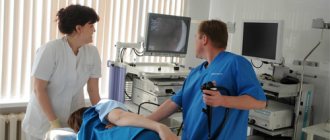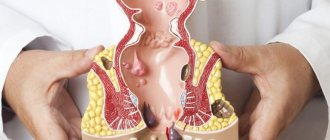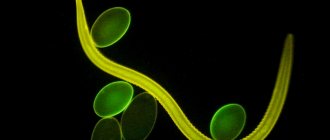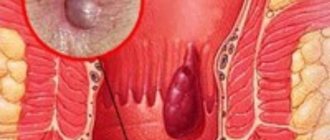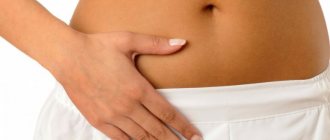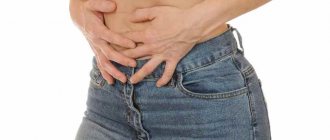Pain in the anus can occur in women of different age groups, during pregnancy or not. There are many causes of pain in the anus in women, and while some of them are harmless, for example, sitting for a long time on a hard surface, others can be a sign of rectal cancer.
To avoid all sorts of complications and the spread of inflammatory processes, you must immediately contact a proctologist and start treatment at an early stage.
Other symptoms and signs
Pain may be accompanied by:
increase in temperature; general malaise; nausea and vomiting; lack of appetite; discharge of blood or mucus from the posterior opening; acute pain in the stomach; diarrhea; flatulence.
The pain may occur during sleep, defecation, or after prolonged sitting. It can radiate to the groin and be acute.
Some types of diseases are accompanied by such severe pain that they can lead to shock.
Why does such pain occur?
Pregnancy
Painful sensations in the anal area during pregnancy are not a normal condition, and if they occur, you should consult a specialist. At this time, the body is as weakened as possible and vulnerable to infections. Most often, hemorrhoids occur during pregnancy, which can be external or internal. If treatment is not started in time, it can become chronic.
Internal hemorrhoids are characterized by nodes in the rectum that are not visible upon visual examination. In this case, the patient may feel a feeling of heat, pain radiating to the sacrum or back, and itching. Sometimes severe bleeding occurs. External hemorrhoids are mainly located around the anus and often lead to pain during bowel movements.
Hemorrhoids can be caused by:
Frequent consumption of alcoholic beverages; Spicy foods; Constipation; Frequent diarrhea; Sedentary lifestyle; Pregnancy and childbirth.
Hemorrhoids develop very quickly if left untreated. The disease is characterized by acute pain when walking, sitting and even lying down. Body temperature may rise and loss of strength may occur. The hemorrhoidal node enlarges and subsequently falls out.
Most often, hemorrhoids appear in the second half of pregnancy. During the birth process, his condition worsens significantly. Women who have given birth to at least one child have hemorrhoids 5 times more often than women who have not given birth. This can be explained by the pressure of the enlarged uterus on the pelvic floor and hemorrhoidal plexus. Childbirth is often accompanied by constipation, which only aggravates the situation.
The appearance of hemorrhoids during pregnancy can affect its normal course and the course of labor.
That is why at the first signs of the disease it is necessary to consult a specialist. If left untreated, hemorrhoids can cause:
Anemia; Arthritis and arthrosis; Diseases of the genitourinary system; Acne.
Diseases of the urinary system
The bladder is located next to the rectum, and any inflammation of it can radiate pain to the anus. The most common bladder diseases:
Cystitis; Stones; Tumors.
The nature of the pain is nagging and aching, occurring when walking. In a calm state, the pain subsides. With acute inflammation, more severe pain is possible, which radiates to the anus.
Gynecological diseases
Often, pain in the rectal area occurs with gynecological diseases and during menstruation. The rectum is separated from the vagina by a very thin septum.
In the rectal area, a large number of vessels are concentrated, which form venous plexuses located under the skin around the anus.
During menstruation, blood flow to the pelvic area increases, which can cause blood stagnation.
This is especially observed in women who have low vascular tone and a tendency to varicose veins. The main signs of blood stagnation are:
Nagging pain in the lower abdomen that radiates to the rectum; Constipation; Pain during bowel movements.
The occurrence of pain radiating to the anus is also possible with:
Adnexite. It is an inflammation of the appendages, which is characterized by pain in the lower abdomen, which radiates to the rectum. Pain increases with bowel movements, coughing and urination. Endometriosis. A very serious disease that is difficult to treat. Causes the drift of endometrial cells to different parts of the body where they sprout. When cells attach to the septum that separates the rectum and vagina, nagging pain is observed during menstruation. Ectopic pregnancy. There is bloody discharge and pain in the lower abdomen, which radiates to the rectum. The nature of the pain ranges from nagging to acute. Apoplexy of the ovary. A serious condition that involves rupture of the ovary. Characterized by acute pain radiating to the rectum. Painful sensations can also occur with congenital bending of the uterus.
Sexually transmitted pathologies
Almost all sexually transmitted diseases can cause pain in the rectum. Bacteria and pathogenic microorganisms, located on the vaginal mucosa, can cause infection of the rectum, which will cause discomfort and pain.
Some of the STDs:
Gonorrhea. Affects the genitourinary system and can spread to the rectal area. The main symptom is purulent yellowish or greenish discharge from the vagina. Papillomavirus. There are many species and types of the virus, some of which can lead to cancer. Most often, papillomas are located on the external female genitalia, in the mouth, but they can also be in the rectal area, causing severe pain. Syphilis. The disease is caused by the bacterium Treponema pallidium. There are several stages of development, the last of which destroys all internal organs. Candidiasis. Infection occurs when the body's immune strength decreases. It can develop on the mucous membranes of the mouth, anus and vagina. Chlamydia. It may be asymptomatic, but is most often characterized by vaginal discharge. There is pain in the lower abdomen, which can radiate to the rectum.
Kryptit
Cryptitis is an infectious disease characterized by an inflammatory process of the transverse folds of the rectum.
You can become infected with this disease through the gastrointestinal tract, rectal contents or sexual contact.
There are primary and secondary cryptitis.
Primary develops in a healthy rectum.
Secondary – in the presence of other inflammatory diseases of the anus.
Main causes of the disease:
Rectal injuries; Frequent constipation and diarrhea; Immune system diseases; Kinks of the rectum; Violation of the process of defecation.
Depending on the causative agent of cryptitis, different forms of its course are distinguished, but the following symptoms are most often observed:
Acute pain during and after bowel movements; Wetness around the anus; Minor bleeding; Feeling of burning and itching.
In acute forms, severe throbbing pain occurs, which is a signal of the formation of an abscess.
With this disease, prolonged constipation is possible, after which the pathology becomes chronic, in which the pain is dull and intensifies at the time of bowel movement.
Papillitis
It is characterized by an inflammatory process on the anal papillae, which are located on the posterior wall of the rectum. It can develop against the background of intestinal diseases such as hemorrhoids, cryptitis and anitis. At the initial stage there are no symptoms, but when the inflammatory period begins, the following is observed:
Sharp pain in the rectum, which extends to the tailbone and genitals; Mucus discharge from the anus; Itching and burning; Blood impurities in stool; Prolapse of the papillae, which resemble a pin, from the anus.
The intensity of the pain depends on whether the papillae are pinched or not, the strength of the sphincter muscle fibers and the presence of mucus. In acute forms, acute throbbing pain is observed.
Malignant tumors and metastases
Chronic diseases of the large intestine, which include proctitis, colitis and chronic anal fissures, can lead to rectal cancer.
Eating fatty and meaty foods and a lack of fiber in the diet often provoke constipation, which leads to constant irritation of the rectal mucosa and the absorption of toxins into the blood, which can also cause cancer and metastases.
The main signs of cancer are:
Frequent diarrhea or constipation; Bloody issues; Pain during bowel movements; Incontinence of feces and gases; Deterioration in general health; Disruption of neighboring organs.
With rectal cancer, the patient necessarily experiences painful sensations that are acute.
Blood, pus and mucus are released from the anus. If treated early, cancer is treatable.
How to treat pain in the anus
The main causes of pain in the anus are hemorrhoids, thrombosis of hemorrhoids, rectal prolapse, paraproctitis, anal canal fissures. Sources of discomfort, sometimes painful, include anal itching.
This entire group of diseases is most often a consequence of an extremely common illness these days - chronic constipation. Imagine a tube of toothpaste: the tube is the rectum, and its spout is the anus, around which there are a large number of veins. The denser the toothpaste, the harder you need to squeeze the tube.
Each bowel movement is a transformation in the rectum of large-diameter feces into a diameter corresponding to the individual's anus. When straining, the outflow of blood from the lower part of the body is disrupted, the veins of the anus swell, and dense feces passing through the anus push these veins towards the exit. The more effort is made to expel feces from the rectum, the more the veins are inflated and the more tissue is injured. Over time, the veins expand, forming hemorrhoids. Depending on the level of the intestine at which the node is protruded, we are talking about external or internal hemorrhoids.
Hemorrhoids can hurt, bleed, become inflamed, and even thrombose. The tissue around such veins can turn into the anus and become inflamed. Venous nodes interfere with the tight closure of the anus, and the contents of the rectum involuntarily come out of it, causing anal itching and other painful conditions.
Similar changes can be observed not only due to constipation, but also with prolonged sitting, pregnancy, and frequent lifting of heavy objects.
If the feces are very dense, then during defecation they can rupture the tissues of the anus, causing anal fissures.
Treatment of pain in these diseases, as well as the diseases themselves, must necessarily include the fight against constipation.
Since pain in the rectal area can have different origins, they are not the same in nature. Thus, with hemorrhoids, patients often complain of a feeling of discomfort in the rectum and anus, itching, burning, stabbing pain, often combined with bleeding. If the pain is sudden, local, intense, burning and directly related to bowel movements, then most likely it is an acute anal fissure. Constant pain in the anal area most often indicates thrombosis of hemorrhoids, acute paraproctitis or rectal fistula. Pressing pain, sometimes associated with defecation, usually accompanies colitis and proctitis. Dull, burning pain accompanying defecation can be caused by an incomplete rectal fistula, cryptitis, or papillitis.
Conditions that require consultation with a doctor: bloody discharge from the anus of a dark red or brown color; tarry, black, or rust-colored stools; if the patient's age is over 50 years; if the patient has a family history of colon or rectal cancer; if the pain is severe or lasts more than a week.
How to treat pain in the anus and other articles from the section Proctological diseases
Doctor consultations and appointments by phone
What causes sharp pain?
Anal fissures. They cause severe pain that is oppressive in nature. There is a delay in defecation and frequent constipation. In the chronic form, pain may not appear. The cause of the disease is a defect in the mucous membranes, which occurs due to injury from foreign bodies or feces. Proctitis. In the acute course of the disease, sharp pain is observed, which is accompanied by a loss of strength and an increase in temperature. At the time of bowel movement, purulent or bloody discharge appears. When proctitis becomes chronic, the pain becomes less pronounced. Thrombosis. Inflammation of hemorrhoidal veins. The disease develops rapidly, which is characterized by increased pain. There is an increase in the hemorrhoidal node, which can fall out. Rectal prolapse. The pain is so severe that the person may lose consciousness. Most often occurs in older women who have had many pregnancies. Treatment is surgical. Anal ulcers. They arise as a result of untreated or improper treatment of anal fissures, hemorrhoids and inflammatory diseases of the rectum. Inflammation of the appendix. Leads to severe pain that radiates to the rectum. In addition, there is a sharp pain in the stomach and area around the navel, in some cases it cannot be localized. Changing position and coughing lead to increased pain. There is an increase in body temperature. Polyps in the rectum. In addition to pain, bleeding, constipation or diarrhea are observed. Requires mandatory removal. Subcutaneous paraproctitis. Other causes of acute pain include subcutaneous paraproctitis, which is suppuration in the rectum. It is characterized by an increase in body temperature and the development of general intoxication of the body.
Pain in the anus
With an anal fissure, severe pain occurs during bowel movements and continues for several hours. They can be so sharp and unbearable that the patient is forced to take painkillers.
The pain radiates to the back, genitals, and bladder, which causes even more discomfort. Such intense pain may also indicate acute paraproctitis, a tumor of the anal canal due to germination of the rectal sphincter. With large tumors, they can move into the coccyx and sacrum, especially when they are compressed and grow into the nerve roots of the sacral region.
With hemorrhoids, pain in the anus usually occurs at stages 2-3 of development. They are very sharp and long-lasting. The patient cannot sit quietly or even move. They arise due to pinching of hemorrhoids. Such symptoms often worsen after ingesting spicy, salty foods or alcoholic beverages.
If the pain becomes constant, this may indicate thrombosis of the hemorrhoids or rectal fistula. With parapraktitis, pain in the anus progresses gradually, the pain may intensify when sitting or awkward movement.
These symptoms occur most often in combination with others. With hemorrhoids, in addition to pain in the anus, a person is accompanied by itching, burning, a feeling of a foreign body, and bleeding. With paraproctitis - increased temperature, decreased appetite, with anal fissure - discomfort in the anus, tingling.
«>
Causes of dull pain
Most often, women feel dull pain in the anus during menstruation. There is an internal cavity between the rectum and the vagina, and during menstruation, a small amount of fluid may accumulate in it, which puts pressure on the anus. The discomfort may last a couple of days, after which it goes away on its own.
Aching pain in the anus can occur with papillitis, gynecological diseases, inflammation of the urinary system, cryptitis and STDs.
If pain occurs only at night, then we can talk about proctological fugue, which is muscle spasms.
This pathology is not a disease and goes away on its own.
Kryptit
This is a disease in which the transverse folds of the rectum become inflamed. It occurs when there is excess, injury, frequent diarrhea or constipation. The disease can also be caused by a malfunction of the immune system.
Cryptitis is characterized by severe pain in the anus, peaking during bowel movements. Blood in the stool and itching may also appear. If you do not start treating the disease in time, it becomes chronic and a dull pain appears in the anus, which becomes regular.
Cryptitis is treated with antiseptic baths, microenemas and, if necessary, antibacterial drugs are prescribed.
What are the most common diagnoses for this condition?
The most common cause of pain in the anus in women is its inflammation, which occurs with colitis, but you should never rule out such a serious disease as cancer. If there is frequent pain in the rectal area and bleeding, the doctor will definitely give you a referral for colonoscopy and sigmoidoscopy. To confirm the diagnosis, a biopsy is performed.
Colonoscopy is a cancer screening and is performed if the patient has not been diagnosed with colitis.
In some cases, a computed tomography scan is performed, which provides an image of the large intestine and evaluates its condition.
It is also necessary to take a biochemical blood test and a urine test to assess the presence of an inflammatory process in the body.
Cystitis and urolithiasis
The bladder is located next to the rectum and if there is inflammation in this area, pain can radiate to the anus. Depending on the disease and intensity of inflammation, the pain may be periodically aching or stabbing.
Cystitis can be caused by bacteria, germs, viruses or hypothermia. Additional symptoms include a frequent urge to urinate, itching and burning in the urethra during this process, and a feeling of incomplete emptying of the bladder. The same symptoms can be observed with renal colic, when the stone moves along the ureter.
To relieve pain, non-steroidal anti-inflammatory drugs (Dexalgin, Ketanov, Baralgin), antispasmodics (No-shpu, Drotaverine), as well as antibiotics are used.
How does the treatment work?
Treatment depends on the diagnosis that will be made and the reason that led to it. Inflammatory diseases of the rectum are treated with antibiotics. Hemorrhoids require mandatory removal. Anal fissures require the use of special ointments that speed up the healing process.
In general, rectal pain is treated with:
Baths. After defecation, antiseptic and anti-inflammatory baths are prescribed. They must be carried out for 15 minutes at a water temperature of no higher than 30 degrees. Baths with the addition of chamomile and oak bark or calendula and yarrow have a good effect. A weak solution of potassium permanganate can be used as an antiseptic.
Ointments and creams. Anti-inflammatory ointments and creams are used that accelerate tissue healing. They need to be administered several times a day after bowel movements and baths.
The most effective ointments:
Ultraproct. It has anti-inflammatory, antipruritic and analgesic effects. The cost is about 500 rubles. Dexpanthenol, Bepanthen. Accelerates tissue healing. Cost 120 rubles. Methyluracil. Has anti-inflammatory and analgesic properties. Cost 80 rubles. Emla. Strong pain reliever. Cost 1600 rubles. Categhel. Anesthetizes and suppresses the proliferation of pathogenic microorganisms. Cost 120 rubles.
Candles. Apply twice a day after defecation. They have anti-inflammatory and analgesic properties.
Popular candles:
Relief. Anesthetizes, heals and suppresses the proliferation of microbes. Cost – 300 rubles. Suppositories with methyluracil. They accelerate metabolic processes, heal and have immunomodulatory properties. Cost 80 rubles. Procto-glivenol. Relieves swelling and reduces pain. Cost 350 rubles.
Before using any medications, consult a doctor. Any medical products have contraindications, which can be found in the instructions.
Traditional methods of treatment
Treatment with traditional methods should not be a reason for refusing to visit a specialist. Home remedies will help temporarily relieve persistent illness, but are not the main treatment.
Recipe No. 1. Treatment of hemorrhoids with potatoes
It is necessary to grate raw potatoes on a fine grater and wrap them in gauze. Before using the product, it is necessary to carry out hygiene procedures. The compress is applied to the area of inflammation and left for 10 minutes.
Recipe No. 2. Sea buckthorn oil
Gives a good effect for hemorrhoids and anal fissures. Use internally and topically. In the morning, it is enough to drink one tablespoon. Oil-based compresses are applied to the anus three times a day, changing them every 3 hours.
Recipe No. 3. Nettle decoction
Take a teaspoon of dry nettle and pour a glass of boiling water. Leave until the broth cools down.
Strain and drink half a glass 3 times a day.
Recipe No. 4. Ichthyol
Cracks that have arisen from hemorrhoids can be lubricated with pure ichthyol. At the same time, consume only liquid food.
Recipe No. 5. Beet juice
It is a good hemostatic agent. Drink 50 ml three times a day.
Prevention measures
Prevention of pain in the anus comes down to:
1. Proper nutrition and avoidance of harmful foods. 2. Compliance with hygiene rules. 3.Moderate physical activity. 4. Timely treatment of inflammatory diseases. 5. For pain in the anus, visit a proctologist, gynecologist and surgeon. 6.Prevention of constipation.
Pain in the anus requires mandatory treatment.
Of course, it wouldn’t hurt to watch the following video on the topic:
They indicate a serious malfunction in the human body. To diagnose the disease and its cause, it is necessary to take tests and undergo additional examinations. Treatment should be carried out exclusively by a specialist.
Malignant neoplasms
The causes of malignant tumors in the rectal area remain unclear. Factors influencing the development of the disease include injuries, polyps, bad habits, poor diet, and digestive disorders.
Pain in the anus is the first sign of anorectal cancer. Blood may also appear in the stool, and at a later stage, pus.
With other malignant neoplasms in the intestinal area, pain appears already at the second stage of the disease. It can be dull, aching or paroxysmal. Malignant tumors are removed surgically.
If you experience pain in the anus, you should consult a proctologist.
Site doctor: Anton Palaznikov
Gastroenterologist, therapist
Work experience more than 7 years.
Professional skills: diagnosis and treatment of diseases of the gastrointestinal tract and biliary system.
Do you still think that healing your stomach and intestines is difficult?
Judging by the fact that you are now reading these lines, victory in the fight against diseases of the gastrointestinal tract is not yet on your side...
Have you already thought about surgery? This is understandable, because the stomach is a very important organ, and its proper functioning is the key to health and well-being. Frequent abdominal pain, heartburn, bloating, belching, nausea, bowel dysfunction... All these symptoms are familiar to you firsthand.
But perhaps it would be more correct to treat not the effect, but the cause? Here is the story of Galina Savina, about how she got rid of all these unpleasant symptoms... Read the article >>>
Pain in the anus in a woman can be caused by various reasons. This is explained by the presence of nerve endings in this area.
That is why even minor cracks that appear in the anus cause uncomfortable and even painful sensations.
Let's figure out what are the causes of strong and sharp pulling, aching, stabbing, dull, shooting and throbbing pain in the anus in women, what treatment is permissible to carry out independently and why, when it hurts, you need to see a doctor.
Symptoms and signs
Pain in women in the anus can be different - dull and sharp, cramping and constant, burning and cutting, and also intensifies at the time of bowel movement.
The following signs may accompany discomfort::
severe itching; diarrhea or constipation; bloating; purulent discharge; symptoms of intoxication; bad feeling; bleeding; anemia; deceptive urge to defecate; sensation of having a foreign object in the rectum.
If you notice at least one symptom, you should immediately go to the doctor , since the source of pain in the anus can be dangerous diseases.
The answer to the question is
why do women often have headaches
, you can find out from this publication.
What can acute pain in the lower abdomen on the right mean in women? Our article will talk about this.
Read about the treatment of age-related urinary incontinence in women in this material.
Proctitis and paraproctitis
The disease is an inflammation of the colon mucosa. If the inflammation spreads to the surrounding adipose tissue, paraproctitis is diagnosed. The causes of these ailments are:
- Abuse of alcohol or spicy seasonings.
- Stool disorders.
- Pathogenic microorganisms.
- Parasites.
The appearance of proctitis and paraproctitis is promoted by anal fissures, gynecological diseases, and diseases of the genitourinary tract.
These diseases are accompanied by a strong burning sensation in the anus and a feeling of heaviness. Additional symptoms include a false urge to defecate, bowel movements are disrupted, body temperature rises, and health deteriorates. There may be weeping or itching in the anal area.
Treatment of proctitis and paraproctitis is carried out using antibiotics from the group of penicillins, cephalosporins or macrolides. Antihistamines are also used to eliminate swelling and reduce itching. Painful sensations are eliminated with antispasmodics and analgesics.
Why does pain occur?
Let's look at the main causes of pain in the anus in women and tell you when treatment is necessary.
Cracks in the wall of the rectum
Discomfort that increases during the process of excreting feces indicates that a crack has formed on the wall of the rectum .
As a rule, the phenomenon makes itself felt only during bowel movements. This happens at the moment of pushing out a too dense fecal bolus.
In rare cases, the rectal mucosa can be damaged by foreign objects that entered the gastrointestinal tract with food and, without being digested, were excreted.
Basically these are all kinds of fruit pits, seed husks, etc.
Diarrhea can also cause discomfort in the anus. To begin with, it is important to establish the cause of diarrhea and eliminate it, and only after that begin to treat the inflammation that has arisen in the anal area.
The source of persistent diarrhea may be the development of diverticulitis (an inflammatory bowel disease), colitis, the presence of polyps or a tumor.
Painful sensations that bother a woman for a long time and intensify at the time of bowel movement indicate that the resulting fissure has become inflamed, that is, it has acquired an aggravated form .
It should be noted that the pain that occurs as a result of the formation of a crack is much more piercing than with hemorrhoids . In rare cases, it becomes so intense that it can cause screaming.
It is for this reason that the act of defecation is delayed. The result is constipation.
Often women experience spasms and pain in the anus, which radiate to the perineum and sacrum. As a result, the functioning of the genitourinary system is disrupted, which often leads to difficulty urinating and disruption of the menstrual cycle.
For some women, the discomfort may last for a long time . The reason lies in regular damage to the wall of the rectum, as a result of which spasms of the sphincter muscles last longer and longer.
Sometimes the pain may linger until the next act of bowel movement follows.
In other words, until the main cause of discomfort in the anus is eliminated, that is, the fissure , the sensations will become more and more intense, and will soon become completely unbearable.
Cracks in the anus may be accompanied by the following symptoms:
piercing pain in the anus during defecation; discharge of a small amount of mucus with blood clots.
Cracks often appear on the back wall of the anal canal , sometimes on the front, and very rarely on both at the same time.
The most serious disease developing in the anal area is considered to be damage to the walls (wounds, cracks) that has spread throughout the entire area of the anal canal. In this case, we can talk about the presence of oncology.
Cancer
Cancer that develops in the rectum does not go away without clinical signs.
The most important symptom of oncology, which cannot be ignored , is the release of bright scarlet blood clots along with stool.
The second, no less significant sign is piercing pain in the anus . The sensations, as a rule, occur during the passage of feces, and do not subside for a long time, but, on the contrary, intensify and become regular.
Sometimes the pain can be transmitted to the genitals, thighs, and lower abdomen.
Perineal injury
Pain in the anus area may not always indicate the presence of cancer.
Many patients complain of discomfort due to regular bowel movements of hard stool.
Trauma to the perineum can also cause pain in women in the anus. This includes falls, bruises, and blows.
You know what they are
signs of high cholesterol in women
? Find out more now!
Is a diet necessary for bladder inflammation in women? Find the answer to the question in this article.
Our publication will tell you whether thyroid cancer can be treated in women.
Dangerous diseases
There are also more serious sources that cause discomfort in the anus in women. This:
venereal diseases; diseases of the urinary system; acute appendicitis; diseases of the genital organs; abscesses (purulent inflammations).
Often, discomfort and pain in the anal area can appear in older women who have undergone more than 3 births .
Haemorrhoids
Hemorrhoids are a disease associated with the expansion of the veins of the rectum and the formation of nodes. More than 15% of the entire adult population suffers from it.
The causes of hemorrhoids can be:
frequent consumption of alcoholic beverages; repeated pregnancies; frequent consumption of irritating foods; heavy physical activity; systematically occurring constipation.
The disease develops quite quickly . The main clinical sign is an increase in pain in the anal area. In rare cases, the sensations may be piercing in nature.
They usually intensify during the passage of feces, as well as in a resting position and during walking.
In addition, hemorrhoids may be accompanied by an increase in temperature and impaired urination.
Acute thrombosis of hemorrhoids
When blood circulation is impaired, blood stagnates , hemorrhoids increase in size and lead to pain in the anal area. As a result, a blood clot may form in the node.
Symptoms of the disease:
sharp piercing pain in the anus during evacuation; bleeding; the anus is swollen; in rare cases, the hemorrhoidal node falls out and becomes dark red; necrosis (death of cells and tissues) of the mucosa.
Paraproctitis
Paraproctitis is an inflammatory process that develops in the anal area.
The cause of the disease is bacteria that penetrate as a result of scratching, injuries, cracks, etc.
Pain in this case occurs during bowel movements and can become unbearable. A swelling in the form of an abscess appears in the area of the posterior sphincter and buttocks . If you don't open it in time, it can break through.
Helminths
Parasites can also cause discomfort in the anus. It manifests itself in different ways, depending on the severity of the problem.
The sensations are often accompanied by fever, chills, itching, burning, rash in the anus and deterioration of the general condition.
Haemorrhoids
This is the most common cause of pain. It is an expansion of the veins of the rectum and is caused by stagnation of blood. Hemorrhoids can be internal or external. The causes of the disease are:
- Problems with blood vessels.
- Frequent constipation.
- Pregnancy and childbirth.
- Hereditary predisposition.
- Poor nutrition.
- Lifting weights.
- Alcohol abuse.
At the very beginning, discomfort and aching pain appear, which intensifies during the act of defecation. Later, after the formation of hemorrhoids, the pain and burning sensation can be very strong, including at night. During bowel movements they become simply unbearable.
In addition to pain in the anus, the following symptoms occur:
- Hemorrhoids. They can form inside and outside the anus. During the second, third and fourth stages, they fall out.
- Blood in stool. Appears due to damage to the mucous membranes.
- Swelling and itching in the anal area.
- In severe cases, an increase in body temperature occurs.
- With prolonged bleeding, anemia occurs.
How to treat hemorrhoids? This question worries many women. In order to get rid of the disease at home, capillary stabilizing agents (Detralex, Normoven, Diosmin) are used. They are taken orally according to the instructions. In order to eliminate fighting sensations and eliminate swelling, inflammation and itching, rectal suppositories are used (Relief, Sea Buckthorn, Anuzol, Anestezol).
The cause of hemorrhoids is a combination of several factors. The main ones include:
- passive lifestyle;
- increased intra-abdominal pressure due to heavy physical exertion or straining to defecate;
- frequent consumption of alcohol, spicy foods;
- hypothermia.
If it hurts during pregnancy
The sensations can be triggered by an enlarged uterus , which puts pressure on all nearby organs, including the rectum. At the same time, constipation develops, which further increases the discomfort.
In addition, the cause of pain can be a change in the shape of the pregnant woman’s pelvis, injuries, or previous operations in the anus.
It is worth noting that the sensations do not cause any harm to either the mother or the child. However, if the pain is accompanied by purulent or bloody discharge , then in this case you should consult a doctor.
When is it okay to help yourself?
Can be used as symptomatic drugs:
ointments (heparin, Vishnevsky, “Proctosan”, “Posterizan”, “Fleming”); creams (“Zdorov”, “Troxerutin”, “Relief”).
Medicines must have anti-inflammatory and analgesic effects. In addition, you should also fight constipation.
Laxatives will help in this case.:
"Senade"; "Duphalac" - can be used by pregnant women; magnesium sulfate powder; suppositories "Glycerin"; "Lavacol", etc.
also recommended to follow a diet .
When a doctor's help is needed
Unfortunately, many women are simply embarrassed to consult a doctor with such a problem . As a result, the pain becomes unbearable, and the accompanying diseases become chronic.
If you experience discomfort in the area of the posterior orifice, you should urgently visit a proctologist.
This applies in particular to cases where:
bloody or purulent discharge appears during bowel movements; the stool turns black; feces become tarry; the pain lasts more than a week; there is a family history of rectal or colon cancer.
A timely diagnosis will help eliminate the cause of discomfort in the posterior orifice in women.
In serious situations, the doctor will prescribe:
antibiotics; drugs that affect veins; hemostatic agents, etc.
Treatment will depend on the severity of the problem.
Papillitis
On the back wall of the rectum there are papillae, which can become inflamed under the influence of negative factors. The reason for this may be congestion in the pelvic area, infections, bowel disorders, or abuse of cleansing enemas.
The disease is characterized by severe pain in the anus, which reaches its peak during defecation. Also, the pain can be shooting or bursting and does not stop even at rest. Mucus (sometimes mixed with blood) may be released from the anus. The patient has a feeling that there is a foreign body in the anus, and the act of defecation does not bring relief.
As a conservative treatment, baths with disinfectant solutions and enemas with antiseptics and astringents are used. You can reduce pain with the help of rectal analgesics.
We invite you to familiarize yourself with the most effective fat burner products for weight loss for women and men
Preventive measures and additional recommendations
To prevent such an unpleasant problem from arising, you should follow some recommendations .
Eliminate rough, spicy foods from your diet. To avoid constipation, eat foods containing fiber (bran, beans, apples, grapefruit, peanuts, almonds, raisins, etc.).
Maintain anal hygiene. After each bowel movement, rinse the anus with warm water. After bowel movements, use soft toilet paper.
Eliminate constipation in a timely manner by taking laxatives.
When engaging in anal sex, use special lubricants to prevent injury to the rectal mucosa.
If discomfort in the anus occurs in women, the cause should be immediately established , since the source of its occurrence may be a dangerous disease.
The anus and rectum are the final part of the digestive system. Therefore, some diseases of the digestive tract can provoke pain in the anus in women - the causes of this symptom, as a rule, are the development of inflammatory processes. But there are other factors that cause this unpleasant clinical manifestation. An important point in diagnosis is to establish the nature of the pain syndrome, its temporary duration and severity.
Why do women experience nagging or aching pain in the anus?
At the beginning of the cycle, most women suffer from premenstrual syndrome, one of the signs of which is a slight nagging pain in the anus. It is felt due to the presence of an internal cavity between the rectum and the uterus (“space of Douglas”). During menstruation, a small amount of fluid accumulates in it, putting pressure on the anus. Usually the discomfort disappears after 1-2 days.
Other causes of the described symptom:
papillitis; cryptite; malignant tumor, metastases in the rectum; gynecological diseases; sexually transmitted pathologies; diseases of the urinary system; pregnancy.
If pain in the anus in women is felt only at night, proctological fugue occurs. This phenomenon is short-term spasms of the rectal muscles. In fact, this syndrome is not a disease; it goes away on its own.
What causes sharp pain in the anus in women?
The acute nature of the pain is presumably associated with the following problems:
anal fissure; thrombosis and inflammation of hemorrhoidal veins; proctitis; protrusion of hemorrhoids outward; rectal prolapse; strangulation of the hemorrhoid; purulent paraproctitis; polyps in the rectum; damage to the digestive system by helminths; presence of a foreign body in the rectum; inflammation of the appendix; anal ulcer.
To clarify the diagnosis and differentiate other diseases, it is necessary to pay attention to the accompanying symptoms of inflammatory or purulent processes, the presence of blood in the stool, the severity of dyspeptic disorders, body temperature, and the condition of the skin around the anus.
For what reasons do women experience severe dull pain in the anus?
This type of pain syndrome is quite rare. In proctological practice, such symptoms are associated with the following diseases:
coccydynia (pain in the tailbone); rectal fistula; inflammation of the pilonidal sinus; anal canal stenosis; rectal cysts; osteochondrosis of the lumbar spine; teratomas; inflammation of the epithelial coccygeal duct; osteomyelitis; chronic constipation; conditions accompanied by frequent diarrhea; neuralgia in the pelvic or lower back area; submucosal abscess in the rectum; subcutaneous paraproctitis; sphincteritis (in combination with other diseases of the digestive system); anal itching.
Moreover, the cause of pain in the anus in women can be a sedentary lifestyle. This phenomenon is especially common in professional activities that require long periods of sitting (office workers, seamstresses, managers, teachers). In such situations, blood circulation in the pelvic area and rectum is disrupted, to which the nerve endings immediately react in the form of dull, weak pain. Also, the discomfort increases if you sit for a long time on a hard or uncomfortable chair without lumbar support.
Anal fissures
Cracks in the anus appear as a result of damage to the mucous membranes. Most often they appear as a result of injury to the surface of the rectum by solid feces. The appearance of cracks can be caused by birth injuries, weakness of the pelvic floor muscles and chronic diseases of the digestive organs.
In most cases, the first sensations of pain appear during bowel movements. A sharp and acute pain lasts several minutes, then its intensity decreases, it becomes aching, and can be felt near the anus. Additional symptoms include:
- The appearance of scarlet blood in the stool.
- Constipation.
- Itching in the anus.
To treat anal fissures, the same medications are used as for hemorrhoids. If the damage is external, ointments are used to improve blood circulation and eliminate pain (Relief, Proctosan, Proctosedyl).
The occurrence of an anal fissure is associated with a violation of the structure of the mucous membrane of the anus. It is usually formed on its back wall, 1-2 centimeters long, the width and depth usually does not exceed a few millimeters. Factors that can provoke such a change are injuries to the anal area, a tendency to constipation, stress when lifting and carrying heavy objects, playing “heavy” sports, and the presence of a source of infection in the body. In women, such a crack forms during childbirth, in the postpartum period.

